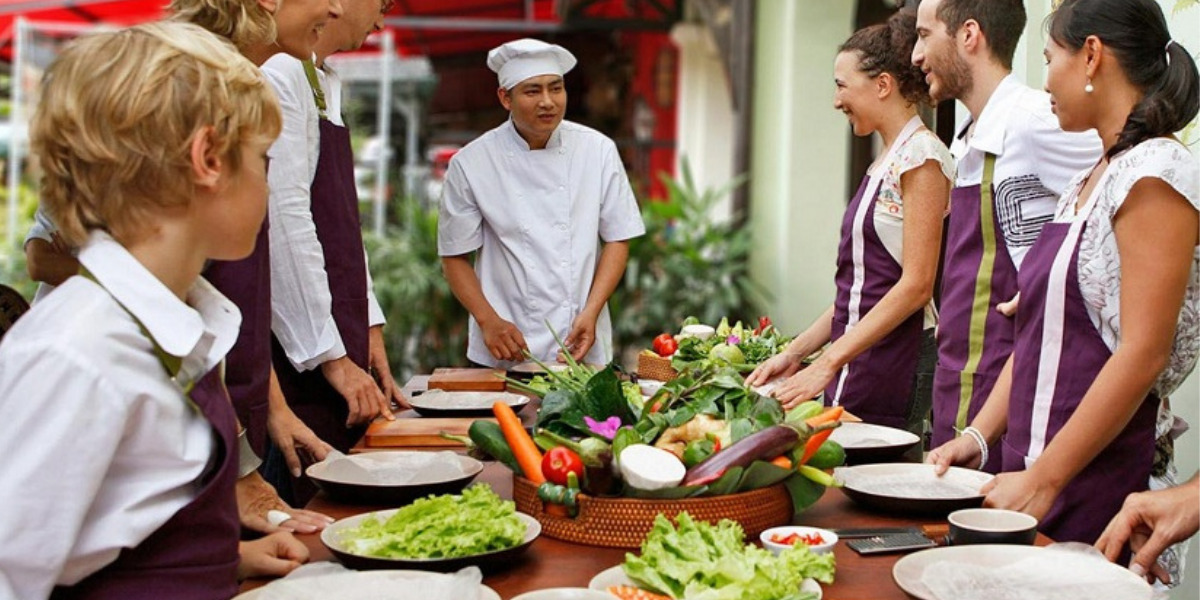Among the most iconic features of traditional culture of Vietnam, the art of painting is one of the most well-known things. Dong Ho paintings are a line of Vietnamese folk paintings, originating around the 17th century in the village of the same name, with 2 families currently still making. This product is created by using wood carving boards - in addition to the strokes, each color on the picture also corresponds to a different board. Dong Ho painting village is also a popular tourist destination not too far from Hanoi, with many extremely fascinating experiences and activities.
I - Artistic imprint of Dong Ho painting
1 - What Dong Ho paintings are made on?
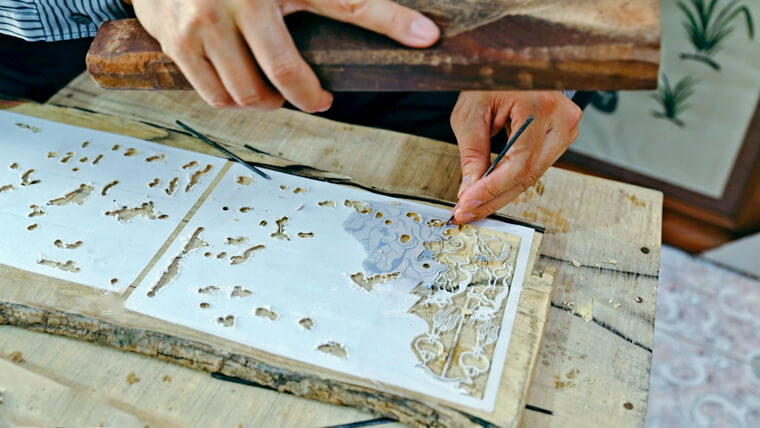
Source: vietnam.vnanet
Painting paper
The traditional Dong Ho folk painting paper is called “diep paper” because it uses powder from crushed diep shells (scallop), mixed with glue and spreaded on (Dzo) dó paper. The glue made from plain rice flour or tapioca flour is often used to spread on the canvas, while the glue made from glutinous rice flour is used to stick. The glue mixture is pasted and swept by a pine needle brush, creating streaks further highlighting the sparkles of the scallop shell debris. The dzo paper to make Dong Ho paintings is strong, bright white and has the ability to bring out the colors drawn on it, and retain them for a long time.
Wood carving boards
In the way of making Dong Ho painting, there are two types of printed boards, which are line printed boards and color printed boards, with the former usually made of linden wood because it has a higher color retention ability. The color printed boards are made of Holarrhena pubescens or Diospyros decandra wood, which has multi-directional grain and soft body, easy to carve with high precision. Board carving tools are chisels made of hardened steel, also known as sets of “ve” that each set have about 30 - 40 pieces.
Colors
Dong Ho paintings' colors are all natural, taken from familiar materials in the countryside such as trees, animals, flowers and grass, etc. Black is obtained from the charcoal of Meliaceae wood, glutinous rice straw or bamboo leaves, which has been thoroughly soaked in jars for months. Blue color comes from copper rust or indigo leaves, which is often used to dye clothes by Northern ethnic minorities, and yellow is from the hoe flowers. The red color from the wine wood or red stone on Thien Thai mountain, and the white color from the scallop shell or eggshell make the colors of Dong Ho paintings.
These raw pigments are mixed together and with a quantity of glutinous rice flour, forming a paste before printing, making paintings harder after drying. These colors stay for a long time on the paper, vibrantly colorful and more eye-catching than normal folk paintings. That’s why most of Dong Ho folk paintings nowadays are criticized for not being as prominent as before, due to the use of industrial colors.
Layout
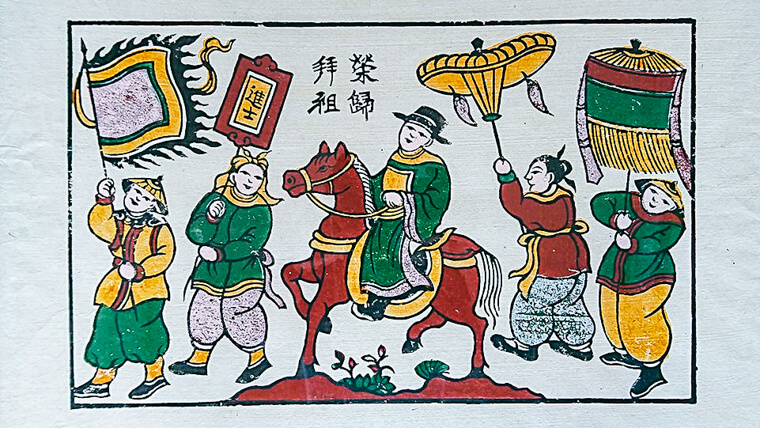
Source: tranhdongho
With Dong Ho paintings, composition is very important, with many basic forms that are diverse and especially suitable for the content. For example, a circular or elliptical layout often creates associations with the cyclic movement of the universe, fullness, center and convergence point. Dong Ho folk Paintings with this layout often show completeness and unity, repetitive and continuous growth, clarifying the change of life. Meanwhile, the triangle and trapezoidal layouts bring a sense of strength, health and longevity, often appearing in paintings with historical themes or daily activities, typically “wrestling”.
A layout of Dong Ho paintings with a similar nature is square and rectangular, showing clear orientation, balance, stability and order. It is often used in the paintings of Dong Ho village with themes related to affluence and sufficiency, along with the harmonious and orderly organization. Finally, a sinusoidal rhythm is a composition of natural beauty, with elements of soft movement and calculated repetition for aesthetic effect. The paintings using this layout often have themes related to rhythmic movement, the laws of the universe and life, reproduction,... typically the “chicken family” painting.
Brushstrokes in Dong Ho paintings
Unlike many other types of paintings, paintings of Dong Ho are painted entirely by prints, including the brushstrokes. In the past, they were printed from wood carving boards, only the Dong Ho village artisans who created the samples could draw. The colors will be printed on the paper first, the black stroke will be added last, then some extra strokes will be drawn to create flexibility if needed. Today, people also paint in other ways, such as coloring on pre-printed pictures and painting on colored paper.
2 - Content shown in Dong Ho paintings
The painting series has diverse contents and forms of expression, but also simple, mainly depicting the authenticity of daily life, production and labor. It’s about relationships between people and people, and between people and nature, showing a deep philosophy of karma, and praying for good things in life. Dong Ho folk paintings are playful and witty, but also poignant and abstract, using anthropomorphized images such as mice, cats, buffaloes, chickens, pigs, etc. Many paintings express the desire to be happy, prosperous and peaceful, that everyone will be in harmony and solidarity.
3 - Some typical Dong Ho paintings
Based on the content, paintings of Dong Ho can be divided into 7 main categories: worship, congratulatory, historical, comic, paintings, landscape paintings and paintings reflecting daily life. “Rat Wedding” is one of the most outstanding works of this traditional folk art, using humorous images of anthropomorphized animals to express human values and profound realism. There are also works showing daily life such as “herding buffalo playing flute”, “catching coconut”, wishing for success and prosperity like “yin and yang pigs”, implying good qualities: “Teacher Toad”,…
II - Dong Ho paintings production process
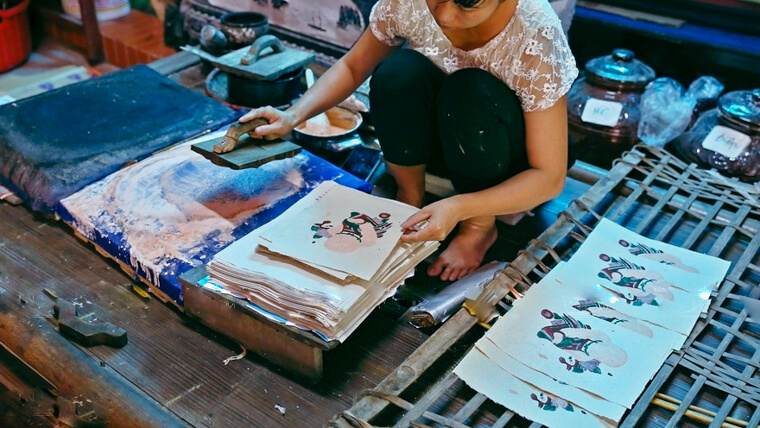
Source: vietnam.vnanet
The Dong Ho folk painting production process has many steps, but it can be divided into 2 main stages: pattern making / carving, and printing / painting. The former is the most important stage that determines the final product, requiring more or less innate talent, high skills and creativity in artisans. It takes a lot of time, from choosing topics, meanings, and content, to getting harmonious colors, tight layouts and high artistic value. When making patterns for Dong Ho paintings, artisans often use quills and Nho ink to draw on thin and flat paper so that the craftsman can engrave on the boards accordingly.
The creation of patterns is not the work of the artists alone, but is often the result of the collective work of the whole Dong Ho village, going through many generations. Therefore, there are cases where one pattern has many different versions, 2 - 3 different color distributions, or ancient paintings whose creators are unidentified. The second stage is to print and paint pictures, creating the final Dong Ho paintings, before which the maker will prepare a set of paper of about 100 to 200 sheets.
They dip the pine needles into the color pot, sweep it on the board and press down several times, so that the color is evenly absorbed on the surface. Then the painter accurately places the printing board on the paper, presses it firmly to have a certain connection, and then turns it all upside down. The loofah is rubbed evenly on the back of the paper so that the color can keep being absorbed, then the paper is removed and left in a cool place until it dries before continuing to print other colors. Black lines must always be printed last.
III - Exploring the village of making Dong Ho paintings
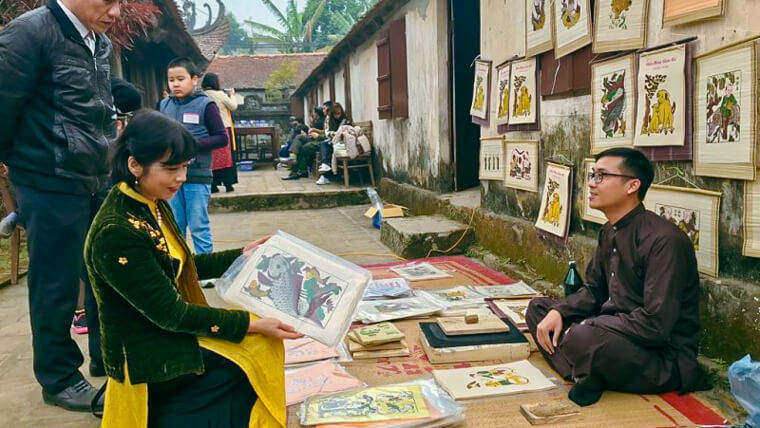
Source: P.B
1 - Location of Dong Ho painting village
Located close to the south bank of the Duong River dyke, this village is also known as Mai village, Song Ho Commune, Thuan Thanh District, Bac Ninh Province - 33km east of the center of Hanoi.
2 - Top things to do in Dong Ho folk painting village
Built in June 2007 and opened on July 25, 2008, Dong Ho Painting Cultural Exchange Center is a model of an eco-tourism conservation area. Covering an area of 5,000m2, this is a place not only to display handicraft works but also where people can exchange and learn about the making process. About 200 Dong Ho paintings, nearly 1,000 engravings and frames, including rare woodblocks dating back hundreds of years that the family of artisan Nguyen Dang Che have collected, preserved, and displayed at the Dong Ho Painting Cultural Exchange Center.
Having visited and traveled to Dong Ho village, do not forget to buy a souvenir to bring back for your relatives or friends. You can buy traditional wood carving paintings, or other creative products such as calendars, ao dai, cloth bags, etc. that bear the style of Dong Ho paintings. You can also learn and participate in many stages of making a typical painting, which will be a meaningful gift.
Every 12th lunar month, especially on the occasion of Vietnamese Lunar New Year, Dong Ho painting village becomes more and more bustling, filled with tourists from everywhere. This type of traditional painting is also known as Tet painting, because this is the main occasion of the year for people to go hunting for good paintings. Its meaning still remains despite going through many ups and downs, and the Tet market is also no longer as prominent as before. Thousands of Dong Ho paintings of all kinds are brought out to be sold, or retailed to families to buy to make Tet hangings, wishing to bring wealth, success and luck.
3 - Entrance fees and opening hours
- Ticket price: Free
- Opening hours: All day
Dong Ho folk paintings is one of the unique traditional arts of Vietnam, imbued with vitality from the creativity and techniques of folk artisans. Over the years and the development of the times, the art of Dong Ho paintings has gradually disappeared, but now only a few families still continue to keep the profession. If you have the opportunity to come to North Vietnam, do not miss visiting Dong Ho painting village, learn and experience how to make this unique art product.







.jpg) — Ha Bich
— Ha Bich


















